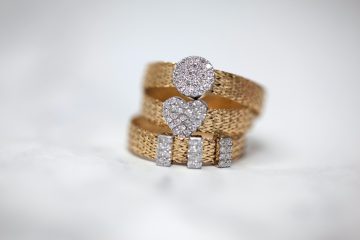For about 3000 years, the human has admired the diamond. This is quite strange since diamonds could not be ground very long ago.
But it was not just the appearance that made the Indians (the first diamonds found in India) worship diamonds. They obviously felt that these glittering stones carried mystical and powerful forces. That they could then also be used to engrave in the hard sapphire and ruby only made it even more desirable.
As still today, it was the white (colorless) diamonds that were the most sought after. These were to be worn only by the caste of the priests.
One of the most famous diamonds is the Indian Koh-i-noor (mountain of light) first mentioned in 1304 and said to weigh over 600ct! It “disappeared” a few hundred years but reappeared in the 16th century. It was then valued at the sum of the entire world’s expenditure for one day! For hundreds of years of bloody battles, Koh-i-noor changed owners many times to finally end up among the English crown jewels. After several grinding, this interesting diamond today weighs 108.93ct.
Scientific facts about diamonds
Diamonds were formed about 20 miles down the earth’s interior many millions of years ago. Carbon in any form, e.g. gas form has crystallized under high pressure and high heat (about 2000 degrees) into the world’s hardest natural material (hardness 10 on the Mohs scale). Note, however, that diamonds can nevertheless be split and even damaged by blows. Even in meteorite strikes on the earth’s surface, such conditions can be created so that diamonds can be formed.
The specific weight of the diamond is “medium” among gemstones (3.52) and the refractive power is very high (2.42). The diamond’s ability to turn white light into small “flashes of color” is called dispersion and is very high compared to other gemstones (0.044).
As mentioned earlier, the first diamonds were found in India about 3000 years ago. Only in the 18th century were diamonds discovered in Brazil and in the 19th century in several African countries as well. Nowadays, Russia and Australia are also important finds.
The first ways to work diamonds were by splitting off gray surfaces, or by rubbing the diamonds against a piece of leather lubricated with diamond powder and olive oil to make these surfaces shiny.
In the 1400s, grinding wheels began to be used, and diamond grinding flourished. The foundation was then added to many of today’s abrasive forms. Then it was an advantage if the grinder was married to a strong wife because she often had to pull around the grinding wheel!
In the 1600s, the term began to be used brilliantly for a grinding that was the first square, but which would eventually become rounder in the 19th century, so that during the first half of the 1900s it becomes the grinding that we today call old grinding.
After the Second World War, the grinding got the proportions that we today call brilliant grinding. This grinding is round with 57 facets, which finish on the underside in a sharp tip.
There are also a number of other classic abrasive shapes such as heart shape, drip shape or square shape (carré).
The 4 Cs of diamonds
A cut diamond is judged by four factors that all start in C. Namely:
- COLOR
- CLARITY
- CUT
- CARAT
CLARITY describes how many, or how large, natural inclusions (fragments of minerals) are found in the diamond. This is assessed by means of a magnifying glass 10 times magnification.
Grinding is the factor that affects the appearance of diamonds the most.
Grinding grades are called:
- VERY GOOD
- GOOD
- Moderate
- BAD
CARAT is only a unit of weight for precious stones and must not be confused with carat which is gold content. One carat corresponds to 0.2 grams.
Diamond care
Diamonds do not require much care, but should be kept clean using the means available from the jeweler or with detergent for glitter. Don’t forget to let a jeweler check that the claws that hold the diamond have not been worn.



